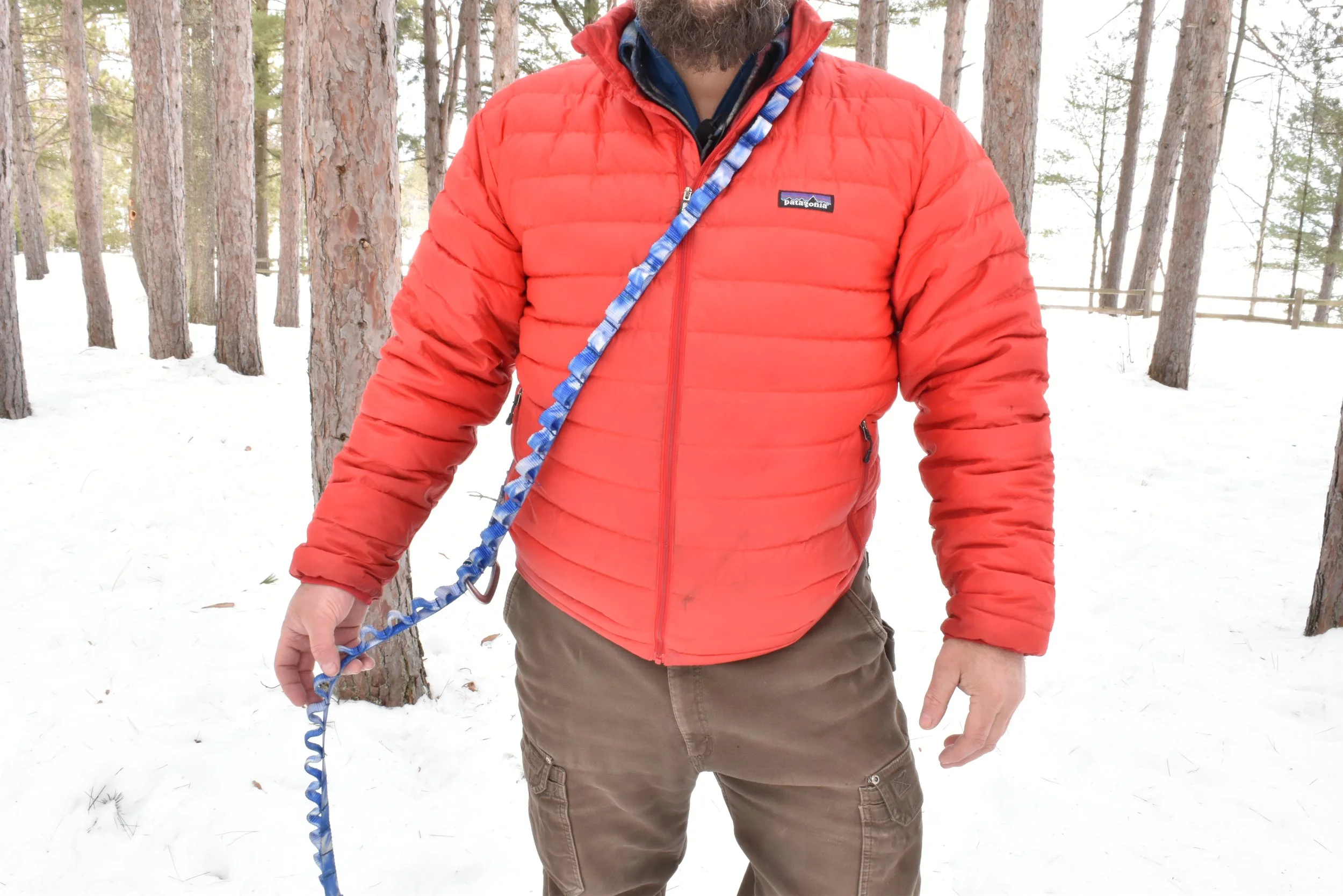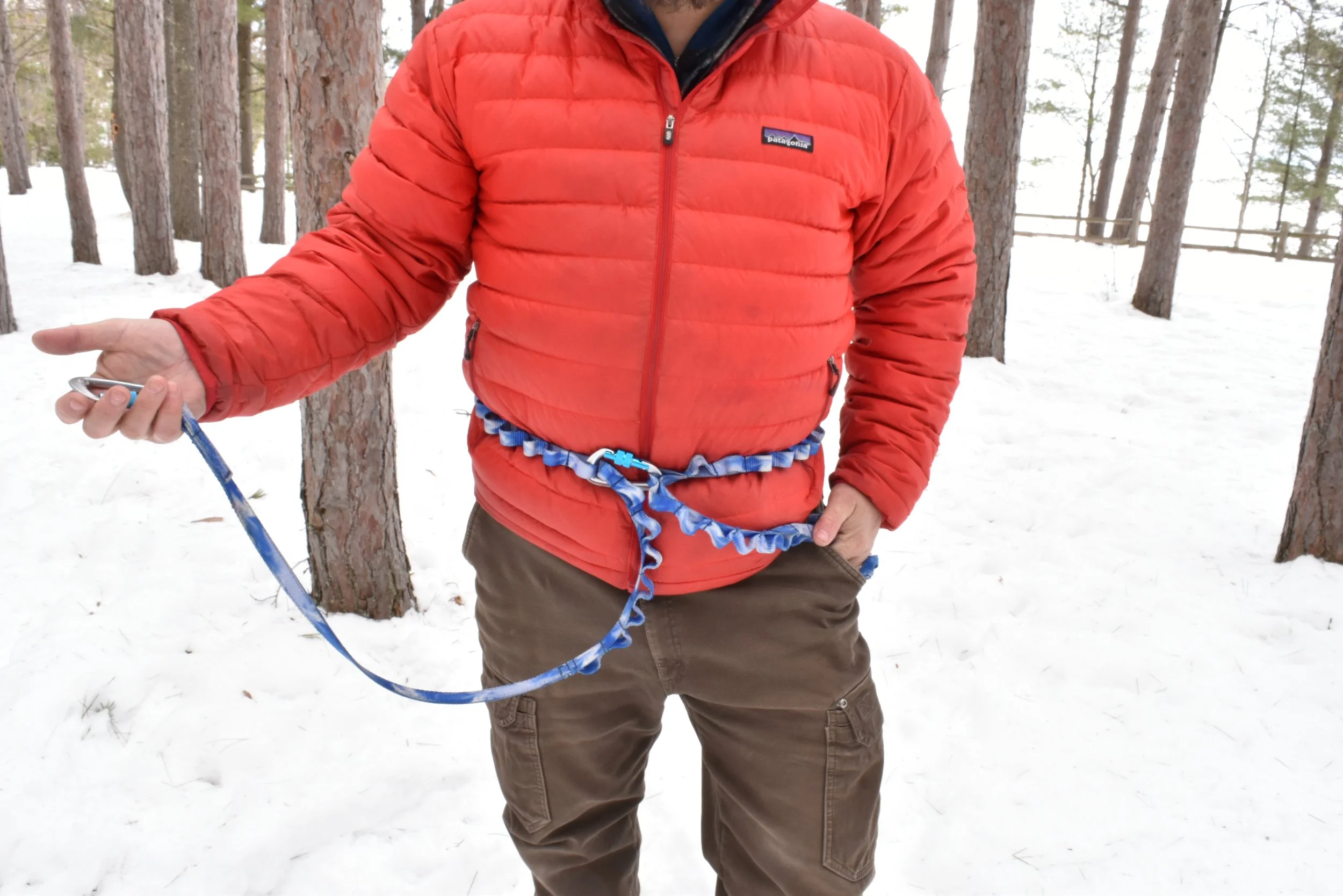nabbitall
A leash is one of those rare things that you actually use, every day, many times a day. We made the first Nabbitall prototype because we couldn’t find a leash that met our daily demands. Everything on the market fell short of our expectations, so we started from scratch and defined new standards for convenience and versatility. Now we can’t imagine using anything else.
Simplicity is the key. Standing loops make it easy to clip into any point of the leash, even under tension. A gate on each end, with an extra one in the middle, means that one leash can fill an extraordinary range of needs… transitioning smoothly between any configuration by opening a hook and clipping to a different loop.
Our first task was to create a hands-free leash that made both hands available for photography, berry picking, and hiking sticks or skijouring. A leash that could be worn around the waist would keep the hands free, while also anchoring the dogs to our center of gravity, but everything we found offered half-measures and inconvenience. Most waist leashes used a separate belt, but we didn’t want to grab a waist belt and a leash every time we went outside. Waist belts also had fussy adjustments that required sliding webbing through a series of fittings, which meant that even if we layered up or down, we’d need to re-slide things back and forth. If another person used the same leash, we’d have to undo their adjustments and dial our own back in. Other waist leashes worked with a system of sliding loops, which meant that the leash itself would go around the waist, but wouldn’t maintain even tension… which meant that every time a dog stopped pulling on the leash, the leash would slip off our hips and entangle our feet. Waist leashes were clunky. We solved all of these problems by reducing the design to a single body with a gated closure at each end.
The body of our leash has closely-spaced standing loops running continuously from end to end, kind of like a belt that has holes from end to end. It doesn’t matter how big or little you are, or how much clothing you’re wearing, or if someone else was just using the leash… getting a perfect fit just means moving the gate to a different loop. One click is all it takes. Because those loops run the full length, you can also clip the gate a few inches from the end to make it a normal hand leash. If you need to anchor your dog to a fixed object, like a trailside tree or a sidewalk doggo hitching post, it again only requires a one-click change. We’ve also found it handy at trailhead parking lots, clipping our dogs to the vehicle while we grab a pack or change shoes.
Having all those loops means that we can clip the person’s end of the leash closer to the dog, which shortens the leash when you want more control. Forming a bigger loop that won’t snug or loosen also makes our Nabbitall great for cross-body wear. In waist configuration, you can pull in any amount of leash to shorten it, open the gate, and simply drop a second loop into the closure. We love this feature for letting dogs roam, but then bringing them in close around more dogs or people. Adding another gated closure means that you can put a dog on each end of the leash, put the middle of the leash on one hip, and clip the third gate to snug the leash to your waist… or hand, or tree.
Security was crucial for us, so the whole thing works without ever having to disconnect your dog. (If you want to use a “normal” leash tethered to an object, for example, you have to remove the leash from the dog’s collar, to then pass the dog-end through the “normal” hand loop.) Even changing between longer and shorter waist configuration keeps the hook engaged in your first loop, it just requires opening the gate to stack or release that second captive loop. We sew the loops so they permanently stand out, which means you can always and easily engage or disengage them. In contrast, when loops are formed by two pieces of webbing sewn flat to one another, a pulling dog can make it difficult to pass your gate through a loop. You never have to hunt or look for an adjustment with the Nabbitall. There’s one more big difference with the Nabbitall: We build it so you can easily replace old hardware. The snaphooks are always the first part of a leash to fail, so we make them replaceable. We typically sew Nabbitalls with a large-ish sewn loop at each end and insert small keynose carabiners. One variant allows nondestructive replacement of fixed-eye swivels (you can replace a busted end without cutting the leash, tearing out stitches, or resewing). A Bluetooth Low Energy (BLE) variant enables remote release of the dog end. It’s geared specifically toward K9 handlers who might need to release a lunging dog while also keeping a firearm on target, but the feature adds convenience for all. You can also sync the BLE variant with a Bluetooth-enabled training collar for buzzing, bumping, and tracking. The Nabbitall is easily the most convenient, versatile, and easy-to-use leash, and it has changed the way we handle dogs. Join us on the trail!














